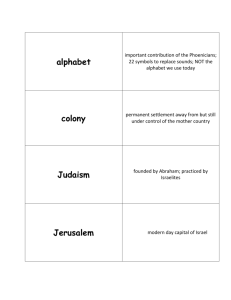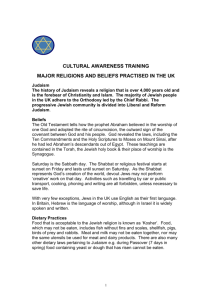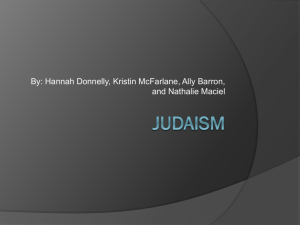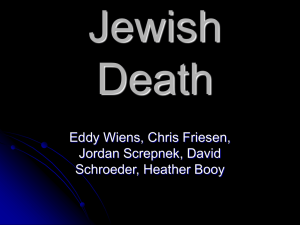TheJewishPers2010nopic
advertisement
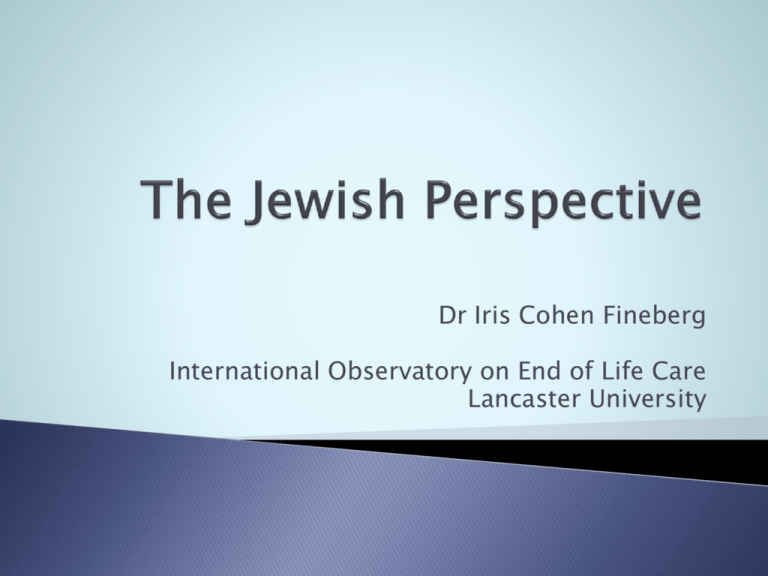
Dr Iris Cohen Fineberg International Observatory on End of Life Care Lancaster University Judaism is full of tradition Across time and geography, changes to traditions have taken place yet many traditions persist Different Jewish groups, with differing histories and degrees of religiosity, may have widely varied approaches Ask two Jewish people...get five answers The sanctity and preservation of life in Judaism is of paramount importance. Jewish law maintains that one has no absolute ownership of one's body. We are given a body for a fixed time. We are obliged to guard it for safe-keeping. We have no rights to tamper with life except for the purpose of preventing its destruction or loss. If a person is considered to be truly at the end of life, it is considered permissible to withhold interventions that would artificially prolong life. Some people would support the withholding of interventions (such as life support) but would not allow the removal of such interventions if they were started. Suicide in Jewish law is forbidden. A person's soul is not his to extinguish, and he cannot not direct someone else to assist him in ending his life. Under no circumstances may a doctor directly kill, or indirectly provide the means for suicide. Any form of active euthanasia is strictly prohibited and condemned as plain murder. Death is seen as a part of life and a part of Gd's plan. The underlying idea for how we treat the dead is that people are created in the image of G-d. There is reverence for the dead, not worship of the dead. Guiding principles in around death and dying in Judaism focus on (a) respect for the dead (kevod ha’met), and (b) care of those remaining. The mourning rituals in Judaism do not indicate a protest of death, but demonstrate the great value Judaism places on life in general and the life of each individual person. A rabbi or central person in the synagogue should be contacted. There are specific rituals for care of the body and preparation for burial. Burial should take place as soon as possible and within 24 hours, following a principle of honoring the dead (k'vod hamet). Only if immediate relatives cannot arrive in time from abroad, or there is not enough time for burial before Shabbat or a holiday, are burials postponed for a day. Anything else is considered a "humiliation of the dead.” After death the eyes are closed and the body laid out. From the moment of death, the body is not left alone until after burial. This practice, called guarding/watching (shemira), is also based on the principle of honoring the dead. Most Jewish communities have a special group of volunteers, the Chevra Kaddisha, whose job is to care for the dead. Women care for women, and men care for men, in accordance with traditions of modesty. Members are responsible for washing the body (Taharah) and preparing for burial in accordance with Jewish custom. They wash the body with warm water from head to foot, and although they may turn the body as necessary to clean it entirely, they never place it face down. The body is never left alone. A family member, a Chevra Kaddisha member, or someone arranged by the funeral parlor passes the time by reciting psalms (Tehillim) as this person watches over the deceased. Dead bodies may not be cremated. Embalming and the removal of organs and fluids (mutilation of the body) is prohibited. However, many Liberal rabbis will officiate at funerals involving cremation and embalming. There are allowances for autopsies and organ donation. The former can be done if it would save a life or if local law requires it; the latter may be done since the organ's eventual burial will fulfill the requirement to bury the entire body. Orthodox Judaism only practices burial for the following reasons: ◦ That it is commanded. ◦ That the body should be returned to the earth. ◦ That the corpse should lie in soil to speed up decomposition. This accounts for the Ultra-Orthodox custom of burying bodies wrapped in shrouds with no coffins. ◦ Because the body should lie and wait for it's resurrection. ◦ It is the only way to give due honour to the body. In the last 100 years since modern techniques of cremation have become available, many Jews have left instructions that they should be cremated. When Jewish cremation takes place the same prayers are said as at a burial. One emotional problem which tends to prevent Jews from opting for cremation is the memory of the fact that many of the Holocaust victims were forcibly cremated in the death camps. The body is dressed in white burial shrouds (tachrichim), which are purposely kept simple to avoid distinguishing between rich or poor. Men are buried with their prayer shawl (tallit), which is rendered ineffective by cutting off one of the fringes. The coffin is plain for the same reason of avoiding distinguishing between rich and poor. It is a simple pine wood box. In Israel, burials are often done without caskets. There are no open casket funerals. Once the coffin is lowered into the grave, family and close friends cover the coffin with a few handfuls of dirt. A Jew who is a Cohen, a descendant of the priestly class, will only attend the funeral and burial of his immediate family as he is otherwise forbidden to come near a corpse. You may see a close friend or relative who is a Cohen remain outside the funeral parlor or cemetery because of this law. Keri'ah (tearing) is the tearing of garment by close mourners. This was an ancient way of expressing grief which existed in biblical times. Originally the tearing was done on hearing of the death. Today, Keri’ah is usually done immediately before the funeral service. When the tearing takes place the mourner says a blessing. Some people pin a black ribbon to their clothing. Keri'ah is only required for those who have lost: ◦ ◦ ◦ ◦ ◦ ◦ ◦ ◦ Father Mother Brother Sister Half-Brother Half-Sister Son Daughter Shiv’ah – the first seven days Shloshim – the first 30 days Year of mourning Yahrtzeit – the anniversary of the death Unveiling – unveiling the headstone at the cemetery; any time after the 30 days Jews do not send flowers but may make a donation to charity in memory of the deceased When paying a Shiva call it is appropriate to bring food, because the person mourning is not supposed to worry about such mundane matters. Being surrounded by family and close friends often helps mourners cope with the immediate loss. Family members find solace from sharing memories of the deceased during Shivah. After the funeral mourners return to the home of the deceased or closest relative and stay there for seven (Shiv'ah) days. (The seven include the day of the funeral.) During the seven days the mourners if strictly observant are required (among other things): ◦ ◦ ◦ ◦ ◦ ◦ ◦ Not to leave the house. To sit on low stools. Not to wear leather shoes. Not to shave. Refrain from sexual intercourse. Not to do business or any manual work. Not to bathe or anoint themselves except for hygienic reasons. A Shiv'ah is interrupted by the Sabbath for that should not be a day of sadness. It is terminated completely when a major festival intervenes. Not everyone observes a full seven days in this way. Because the mourners do not go out to attend synagogue services, services are held each day in the home. Friends and relatives come to visit. Comforting mourners is considered a commandment (mitzvah). The visitors also help to make up the minyan (10 people) for the prayers. Many present day mourners feel that they have a duty to supply refreshments for the people who call during the seven days. However the original Jewish tradition was quite the opposite. Mourners were thought not to be in a fit state to prepare food and the friends and relatives who visited were expected not to call empty handed but to provide food for the mourners. The first meal after the funeral either contained lentils or eggs. The latter being a symbol of new life. It is now common practice for people to cover mirrors in a house of mourning or else turn them to face the wall. It is however not required and appears to be just a folk custom that originated outside of Judaism. One reason is to reflect that as mourners we should not have vanity (worry about how we look). Throughout the seven days of the Shiv'ah a light is kept burning. The light may be symbolic of the soul of the departed. We use a light to remember someone who brightened our lives when we light a Yahrtzeit candle. Amid the sadness and gloom of mourning, light is a symbol of hope and of comfort. At the end of the year a matsevah (tombstone) is put on the grave. Stone masons recommend that relatives wait at least six months before erecting a stone as the ground needs at least that time to settle. The Sephardim usually have horizontal stones, so that nobody is higher than anyone else in death. Many Ashkenazi cemeteries have a height limit for the same reason. It is the custom to have a short service of consecration around the stone (unveiling), which often also serves to mark the end of the year of mourning. When people visit a grave it is a common practice to place a small pebble on the grave to show that one has visited. The origin of this custom may possibly go back to Biblical times. By placing a pebble on the grave the visitor is helping to preserve the memory of the dead person. A Yahrtzeit is the anniversary of the death of a parent. The word is Yiddish and means a year's time. Although it was originally introduced as a day to say Kaddish (a specific prayer) for a mother or father, today, many also keep the Yahrtzeits of other close relatives. The day is observed by the lighting of a memorial light and by keeping it burning for the full Jewish day from sunset to sunset. It is usual to attend Synagogue on that day or on the Shabbat before the date to say Kaddish. Jewish sacred texts and literature have little to say about what happens after death. Judaism is much more focused on actions than beliefs, with a focus on the commandments (mitzvot) to be performed in this life. Jewish holy texts focus on the purpose of earthly life, which is to fulfill one's duties to G-d and one's fellow person. Whether anything at all happens after death, is not as important. Variation is the rule rather than the exception ◦ Even when principles are similar, traditions vary ◦ Each community may have certain traditions ◦ Each family will have views, needs, and traditions It is better to ask a patient and family what their views, wishes and traditions are rather than assuming that because they are Jewish they subscribe to any particular set of ideas and traditions. The Jewish Way in Death and Mourning by Ethnic Variations in Dying, Death, and Grief: Diversity in Universality, edited by Donald P. Maurice Lamm (Jonathan David Publisher, 1969; new edition published in 2000) Irish, Kathleen F. Lundquist, Vivian Jenkins Nelsen (Taylor & Francis Publishers, 1993). Cross-Cultural Perspectives in Medical Ethics (2nd ed.), edited by Robert M. Veatch (Jones and Bartlett Publishers, 2000) http://web.ukonline.co.uk/lawrence.rigal/jewish/cust oms/index.htm United Jewish Communities/Jewish Federations of North America http://www.ujc.org/page.aspx?id=937 http://www.religionfacts.com/judaism/cycle/death.ht m http://judaism.about.com/ http://www.jlaw.com/Commentary/AsstSuicide.html
